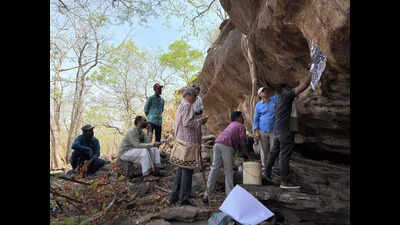Hyderabad: The Archaeological Survey of India (ASI) has shed new light on Telangana’s ancient political landscape with the discovery of 11 inscriptions dating back to the Shatavahana period. Unearthed during a recent expedition by its epigraphy branch to the Gundaram Reserve Forests, two of these inscriptions are now being hailed as critical evidence of Telangana’s role in early Indian polity and dynastic alliances.
“In one word, the frozen mystery of Telangana history is unravelled,” said ASI epigraphy director K Muniratnam Reddy, summarising the significance of the find. His remarks come in the backdrop of earlier discoveries — particularly an inscription from Mukkataropeta in Karimnagar — which had indicated that Telangana was part of Asmaka, one of the sixteen Mahajanapadas that flourished in the 6th century BCE. The Gundaram inscriptions provide fresh, corroborative evidence to that theory.
Of the 11 inscriptions copied, two from a rock shelter at Gundaram stand out. One mentions a figure from the Hāritiputra lineage — likely from the Chutu dynasty — described as a mitasa (friend) of Kumāra Hakusiri, a Satavahana prince. It records that the figure excavated a cave for the benefit of Buddhist monks.
The inscription reads: “Sidham Haritiputasa Kumarasa Akusiri mitasa īdha gamitam.”
According to Reddy, this line offers rare, direct evidence of a cordial, possibly political, relationship between the Chutu and Satavahana dynasties — offering a crucial clue to understanding inter-dynastic alliances in the early Deccan history.
The Chutus ruled parts of the Deccan between the 1st and 3rd centuries CE, with Banavasi — located in present-day Karnataka — as their capital. Another inscription from the site features a trident and damaru — auspicious symbols rarely seen in early South Indian records. It also mentions a figure named Devarāna who held authority over the eastern side of the hill.
The initial discovery was made by noted photographer Ravinder Reddy, following which the ASI team carried out the documentation after securing forest clearance.








